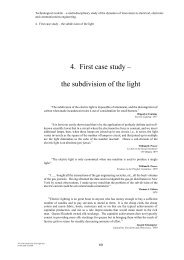Valuation Techniques for Social Cost-Benefit Analysis: - HM Treasury
Valuation Techniques for Social Cost-Benefit Analysis: - HM Treasury
Valuation Techniques for Social Cost-Benefit Analysis: - HM Treasury
Create successful ePaper yourself
Turn your PDF publications into a flip-book with our unique Google optimized e-Paper software.
32<br />
o Market imperfections<br />
o Measuring WTP <strong>for</strong> non-marginal changes<br />
o Marshallian versus Hicksian demand<br />
Life Satisfaction Approach<br />
o <strong>Cost</strong>-effective<br />
o Reasonably wide application<br />
o Fewer survey-related biases<br />
o No market structure assumptions<br />
o Difficulties in estimating the marginal utility of income<br />
o Difficulties in estimating the marginal utility of the non-market good<br />
4.3.1 Stated Preference Methods<br />
Advantages<br />
i) Wide application and specific valuations<br />
Stated preference methods can, in principle, be used to value any specific non-market good.<br />
Choice modelling methods can also be used to estimate the value of the attributes of a nonmarket<br />
good. This can be useful if different policy options differ in the attribute levels that they<br />
provide (Mourato et al, 2005).<br />
ii) Allows one to explore the reasons behind preferences<br />
Stated preference questionnaires can include questions relating to:<br />
o the respondent‘s characteristics or attitudes toward the non-market good; and<br />
o the reasons behind the respondent‘s choices or answers to the WTP/WTA questions.<br />
Exploring the variation in responses is useful <strong>for</strong> identifying the winners and losers of an<br />
intervention. This is useful <strong>for</strong> stakeholder analysis (Bateman, 2002). It is also helpful that,<br />
through the development of a primary questionnaire, groups can be defined by characteristics<br />
which are typically unobserved on the conventional datasets used in revealed preference or life<br />
satisfaction studies.<br />
Uncovering the reasons behind respondents‘ answers can also be helpful. For example, in<br />
hedonic pricing studies, it is often identified that house prices increase with the air quality in<br />
their neighbourhood (Smith and Huang, 1995). The exact reason <strong>for</strong> this correlation is often not<br />
clear. For example, it could be due to lower cleaning bills, the neighbourhood being more<br />
aesthetically pleasing, or due to the health damages associated with polluted air (Portney,<br />
1981).<br />
iii) Ex-ante application<br />
The value of any specific policy or intervention can be estimated be<strong>for</strong>e it is actually<br />
implemented. There<strong>for</strong>e stated preference methods can aid decision-making at an early stage of<br />
the policy cycle. Other valuation methods can be used ex-ante however they rely on an implicit<br />
assumption that the preferences revealed in the past do not change in the future.<br />
iv) Widely used and researched<br />
There have been a large number of applied contingent valuation studies. Carson et al (1995)<br />
present a bibliography of over 2000 studies from more than 40 countries and Carson (2004)<br />
presents a bibliography that exceeds 5000. In addition to application, the reliability and





![AIRTO [Professor Dr Brian Blunden] - HM Treasury](https://img.yumpu.com/15492848/1/184x260/airto-professor-dr-brian-blunden-hm-treasury.jpg?quality=85)










